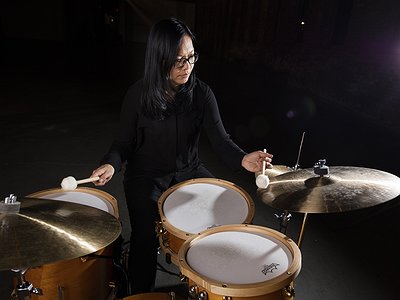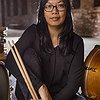Part 1
Name: Susie Ibarra
Nationality: American
Occupation: Percussionist/Composer
Current Release: Perception
Recommendation: Njideka Akunyili Crosby’s figurative paintings from The Beautyful Ones Series I find striking and beautiful in their composition, depth and color / Nana Vasconcelos’ Saudades on ECM records. A classic recording I’ve loved and am listening to again recently.
Website / Contact: If you enjoyed this interview with Susie, visit her website www.susieibarra.com for more sounds and news.
When did you start playing your instrument, and what or who were your early passions and influences? What is about music and/or sound that drew you to it?
I began playing piano at three, studying classical piano throughout grade school and playing piano and organ at church. I began playing drums and percussion when I was 16 years old. The first album I bought was Michael Jackson Off the Wall, I also remember listening to the college jazz station and they were playing Monk’s Dream, and it drew me in. 10 days after I got my first drum set, I was invited to play in a punk band.
For most artists, originality is first preceded by a phase of learning and, often, emulating others. What was this like for you? How would you describe your own development as an artist and the transition towards your own voice? What is the relationship between copying, learning and your own creativity?
I still love to study and learn music. I’m into field recording and researching environmental sounds as well as human sounds too. I’m into learning styles of percussion from around the world and continue to practice as a drummer and percussionist, refining and exploring my technique. So much great music has been given to us already; I like to celebrate it, learn from it and let it inspire me. Although I’m a contemporary artist, I’m very much influenced by traditional music as well. Life’s experience continually shapes my individual creative voice.
What were some of your main artistic challenges when starting out as an artist and in which way have they changed over the years?
Initially I was very frustrated by not being able to play and write what I would hear in my head. It’s a lifelong path of continually learning to communicate, express and create with these pure elements that influence my music practice. It’s also shaped and informed how I gravitate to performing and creating music with diverse artists and non-artists.
Tell us about your studio/work space, please. What were criteria when setting it up and how does this environment influence the creative process? How important, relatively speaking, are factors like mood, ergonomics, haptics and technology for you?
I’ve moved in the last two years, so I think I’m still settling into organizing my music studio at home. I also have to switch them around if I am writing, or performing certain percussion instruments. But the instruments I play I have to sit at, so that practice has been ongoing and very important to me to feel comfortable and at home behind instrument/s wherever I am practicing or performing.
Tell me about your instrument, please. What was your first instrument like and how did you progress to your current one? How would you describe the relationship with it? What are its most important qualities and how do they influence the musical results, including your own performance?
I’m a percussionist. While I started on piano, I moved to a drum set, Philippine and Indonesian gongs and bamboo, and I began to play an array of percussion too – timpani, congas, djembe, and now recently Burmese pat waing and Thai gongs. I like to collaborate interactively using surround spatial sound, mobile apps, speaker installations. I also like to write for various instruments – percussion, woodwinds, strings, electronics, voice. In the last 15 years, I have been integrating field recordings into my sonic work. I still feel my principal performance instruments are extended drum set and Philippine kulintang gongs. Whatever the palette - natural or musical instruments - I’m looking for musical elements to compose the work.
Could you take us through a day in your life, from a possible morning routine through to your work? Do you have a fixed schedule? How do music and other aspects of your life feed back into each other - do you separate them or instead try to make them blend seamlessly?
I don’t think music begins or ends in one place for me. I do feel like life for me, is about playing polyrhythms and balancing the interdependence of things.
Whether I am walking my dog, taking care of my son and getting him ready for school, or teaching at college, or sitting at my kitchen table or the music room practicing or writing music, taking care of correspondence, yoga, or in rehearsal, tech or on tour – there is a ritual …a warm up, a listening … and a dedication to making an effort to be sincerely in the moment as well as preparing for the next moment, be it as a performer or a listener.
Could you describe your creative process on the basis of a piece or album that's particularly dear to you, please? Where did the ideas come from, how were they transformed in your mind, what did you start with and how do you refine these beginnings into the finished work of art?
I recently released the album Perception, for my six-piece band, DreamTime Ensemble. These pieces were written after overcoming grief and being sensitive to the heightened sensory experiences that we each have. I had read in the writing of Lao Tzu’s Tao Te Ching about justice and fairness. It was something I really related to and I realized in this moment that I didn’t believe in justice and fairness, but I did believe in kindness and goodness and love. It surprised me a little bit. I wrote the album as a suite of pieces that would weave these thoughts into music scores and recorded them with an incredible ensemble including Claudia Acuña- voice, Jennifer Choi- violin, Yves Dharamraj- cello, Jake Landau- piano/keyboards & guitar and myself on drums,percussion and hourglass harp with Jean-Luc Sinclair collaborating on electronics to remix an overture of the recorded ensemble titled “Collective Memory” and an interlude “Sensing Light”. Sound Engineer and producer Olivier Chastan of Decibel Collective engineered and produced the album.
It was a two-part creation, writing and recording the music for the album and bringing the music into a live performance. I both multi-tracked and recorded the compositions live to tape. Much to my surprise, the sequence order worked well as a live program offering spaces to expand improvisation and to develop ambience.
There are many descriptions of the ideal state of mind for being creative. What is it like for you? What supports this ideal state of mind and what are distractions? Are there strategies to enter into this state more easily?
For me it’s when I am open, present and listening to what is going on inside and my surroundings. I also trust the creative practice. Showing up and creating, even when there are distractions or it is a difficult day is part of it too. The interdependence of everything and trusting that continuity and rigour in practice that can really support our creative process and growth.






